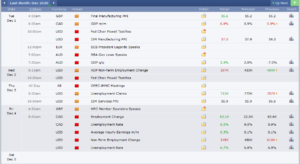These announcements can range from elections or changes in a company’s liquidity to GDP and interest rate decisions.
Each week, there are economic events of which every forex trader should make themselves aware.

Every event on an economic calendar is graded according to how much of an impact it’s likely to make on the financial system. Grading ranges from ‘low’ (which doesn’t carry any special markings on the calendar), to ‘medium’ (marked with yellow), and ‘high’ (marked in red). Red events are likely to have a significant effect on the market.
With exposure to an economic calendar, you’ll get a feel for what days will see more or less volatility in the market and make trading decisions accordingly. On the whole, GDP, non-farm payroll and unemployment announcements have the biggest impact on international markets.
A key point to bear in mind: it’s important not to get tunnel vision when it comes to the specific currencies you track and keep your eyes on the bigger picture. For example, fluctuations in USD often have a huge international impact, and it’s important to be aware of the broader fluctuations that result.
Staying up to date with the economic calendar gives both beginners and advanced traders an edge in the market. For novices, being aware of more volatile days will guide you on when to steer clear of trades. An economic calendar can also help less experienced traders understand how markets behave around the time of news releases – a critical and ongoing learning process.
More experienced traders also tend to avoid volatility around high-impact events. Professional forex traders will close out their deals three to five minutes before a big announcement. They will also avoid making trades until any important information has been released.
These techniques help avoid ‘slippage’ – when you get a dramatically different price for your trade because of market movements between the time a trade is ordered and when it’s executed.

